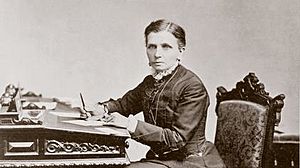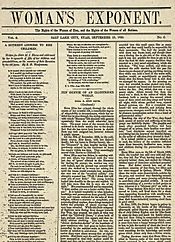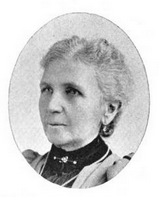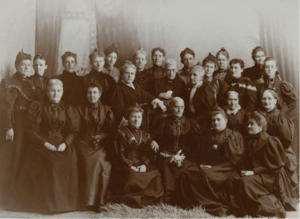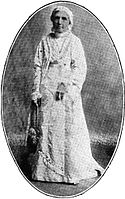Emmeline B. Wells facts for kids
Quick facts for kids Emmeline B. Wells |
|
|---|---|
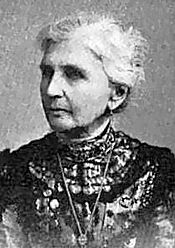 |
|
| 5th Relief Society General President | |
| October 3, 1910 – April 2, 1921 | |
| Called by | Joseph F. Smith |
| Predecessor | Bathsheba W. Smith |
| Successor | Clarissa S. Williams |
| Personal details | |
| Born | Emmeline Blanche Woodward February 29, 1828 Petersham, Massachusetts, United States |
| Died | April 25, 1921 (aged 93) Salt Lake City, Utah, United States |
| Cause of death | Stroke |
| Resting place | Salt Lake City Cemetery 40°46′38″N 111°51′29″W / 40.7772°N 111.8580°W |
| Spouse(s) | James Harris Newel K. Whitney Daniel H. Wells |
| Children | 6 Eugene Henri Harris (1844–1844) Isabel Modalena Whitney Sears (1848–1941) Melvina Caroline Blanche Whitney Dunford Woods (1850-1940) Emma Whitney Wells (1853-1878) Elizabeth Ann "Annie" Wells Cannon (1859-1942) Louise Martha "Louie" Wells Cannon (1862-1887) |
| Parents | David and Diadama H. Woodward |
Emmeline Blanche Woodward Harris Whitney Wells (born February 29, 1828 – died April 25, 1921) was an important American writer, editor, and champion for women's rights. She also kept a detailed diary of her life. She led the Relief Society, a women's organization of The Church of Jesus Christ of Latter-day Saints (LDS Church), from 1910 until her death.
Emmeline Wells was a strong voice for women in Utah and across the United States. She spoke at national meetings for women's voting rights and was the president of the Utah Woman's Suffrage Association. For 37 years, she was the editor of a newspaper called the Woman's Exponent, which focused on women's issues.
Contents
Emmeline Wells' Early Life
Emmeline Blanche Woodward was born in Petersham, Massachusetts, on February 29, 1828. She was the seventh child of David and Diadama Hare Woodward. Her father passed away when she was only four years old. Emmeline later said that her widowed mother inspired her to become a supporter of women's rights.
When her mother remarried, the family moved to North New Salem, Massachusetts. Emmeline spent ten years of her childhood there. Religion was a big part of her early life, and her family attended the local church. As a child, she loved writing poems and stories, which she shared with her friends. She also enjoyed spending time in nature. Emmeline was very smart and went to public school before attending the New Salem Academy. She graduated from the Academy when she was just fourteen.
The religious "revivalist movement" changed the community in New Salem. Emmeline's family and friends joined the LDS Church on March 1, 1842. After her baptism, she continued her schooling. When she tried to become a teacher, her new faith made it difficult to find work. However, she kept trying and taught school briefly in Orange, Massachusetts. She then married for the first time at age fifteen.
Emmeline's Marriages and Family
First Marriage and Challenges
Emmeline married James Harris, who was also fifteen and a new church member, on July 19, 1843. This marriage was hard for young Emmeline. Her mother-in-law did not approve of her, and Emmeline felt unprepared for married life. She later wrote that she regretted marrying so young.
Life became even harder when Emmeline, James, and his family moved to the Mormon settlement of Nauvoo, Illinois, in 1844. After a while, James's parents left the church and Nauvoo, leaving Emmeline and James alone. She gave birth to a son, Eugene Henri, on September 1, 1844. Sadly, Emmeline had been sick during her pregnancy, and her baby son also became sick and died at six weeks old. After losing her son, Emmeline said goodbye to her husband, who left to find work. He asked her to return to his parents, but she refused. James Harris later died as a sailor and never returned.
Second Marriage and Moving West
After James left, Emmeline Harris began teaching again. Through her school, she met Newel K. Whitney. On February 24, 1845, she married him as a plural wife, which was a practice in the early LDS Church. Emmeline admired Newel Whitney and felt much safer as his wife.
In 1846, she left Nauvoo with the large Whitney family. They traveled from Winter Quarters, Nebraska, to Utah Territory in 1848. During this journey, Emmeline became close with her sister-wives. She also started writing in her first journal, which would become one of 47 journals she kept throughout her life. She was pregnant when they arrived in the Salt Lake Valley on October 8, 1848. Her first daughter, Isabel "Belle" Whitney, was born in the same wagon that had carried her mother across the country. Emmeline later said, "our poor wagons and tents were the only homes we had." Her second daughter, Melvina Whitney, was born in 1850.
Sadly, this happy news was followed by her second husband's sudden death. Emmeline deeply mourned his passing. By age 22, she had been widowed twice. Before he died, Newel Whitney had told her that she would become "a tremendous influence in the building of the kingdom in the west."
Third Marriage and Later Life
Newel Whitney's death in 1850 meant Emmeline had to start teaching school again to support her daughters. She was mostly responsible for earning her own money for the rest of her life. She then approached Daniel H. Wells, a friend of her late husband and a respected community leader, about marriage. In 1852, she became his seventh wife.
Their early marriage was distant because Daniel Wells was very busy with his civic and church duties and had six other families. Emmeline Wells lived separately from his other wives. She had another daughter, Emma "Emmie" Wells, in 1853. During the Utah War in 1857, Emmeline moved south to Provo, where she continued to teach. In 1859, she gave birth to her fourth daughter, Elizabeth Ann Wells. Her fifth daughter, Louise Martha "Louie" Wells, was born in 1862. So, she and Daniel Wells had three children together.
Even though their early relationship was difficult, they became loving companions later in life. Emmeline Wells did not regret being part of polygamy. Daniel Wells passed away on March 24, 1891. By the end of her life, Emmeline Wells had been widowed three times. Once her children were grown, Emmeline dedicated herself to writing.
Emmeline Wells' Contributions
Writing for the Woman's Exponent
Emmeline Wells loved writing poetry and stories from a young age. Her career truly took off with the articles she wrote for the Woman's Exponent. This newspaper started in 1872 and shared news about women in the LDS Church. It also published articles supporting women's rights to education, economic opportunities, and voting.
The Exponent became part of a national network of feminist newspapers, helping Emmeline's voice reach beyond Utah. She wrote many articles about women's rights, especially the right to vote and to hold public office. Using the pen name "Blanche Beechwood," she published 40 articles strongly arguing for voting rights, social changes, and religious freedom.
Emmeline Wells became the Exponent's associate editor in 1875. From 1877 to 1914, she was the main editor, publisher, business manager, and owner of the newspaper. As editor, she was known for her great organizational skills and amazing memory. She continued to publish her own essays and poems, sometimes using the pen name "Aunt Em." At the request of church president Brigham Young, she also wrote and collected life stories of many Latter-day Saint women for the Exponent. Her writings showed a mix of feminist and romantic ideas, along with her religious beliefs. The Exponent was a place for LDS women to share their thoughts, including about polygamy.
Near the end of her time as editor, Emmeline asked her daughter Annie Wells Cannon to be her assistant. The Exponent closed in February 1914 with Emmeline's last editorial, "Heartfelt Farewell."
Emmeline continued to write many short stories and poems, and many were published. She even published her autobiography, called "Hephzibah," as a novel in the Exponent between 1889 and 1890. She later collected her poems into a book called Musings and Memories, which was so popular she published a second edition in 1915. This book contained 130 of her poems, mostly about nature, friendship, or faith. In 1912, Emmeline Wells became the first woman in Utah to receive an honorary degree in literature from Brigham Young University.
Advocating for Women's Rights
When women in Utah gained the right to vote in 1870, Emmeline Wells was among the first to vote in local elections. In 1871, famous women's rights activists Elizabeth Cady Stanton and Susan B. Anthony visited Utah. Emmeline attended their meeting and was greatly inspired. She wanted more freedom and independence for her five daughters.
She became an early supporter of women's rights, writing for the Woman's Exponent under the name "Blanche Beechwood." She did not believe in the traditional role of women in Victorian society. Through her anonymous writings, she shared her frustration with how society viewed a wife's role. She wrote 43 essays for the Exponent and became its editor in 1877. Besides reporting news about the Relief Society, she used the newspaper to support women's voting rights and better educational and economic chances for women. She often communicated with women's rights leaders and other pro-suffrage editors across the country.
In 1879, national feminist leaders Elizabeth Cady Stanton and Susan B. Anthony chose Emmeline Wells to represent Utah at a suffrage convention in Washington, D.C.. She and Zina P. Young Card were the first official representatives of LDS women at a national women's conference. In Washington, Emmeline spoke out against laws that aimed to take away voting rights from Utah women because of polygamy. She and Zina met with President Rutherford B. Hayes and First Lady Lucy Hayes to explain their situation. President Hayes thanked them for sharing their views. Emmeline also spoke to committees in the U.S. House and Senate. Even though some people made fun of them for attending the convention, Susan B. Anthony defended their right to be there.
Emmeline Wells also pushed for women to be able to hold public office in Utah Territory. In 1878, she turned down a nomination for Salt Lake County Treasurer because women were not allowed to hold office then. In 1879, she urged Governor George Emery to support women holding office, but he refused. In 1880, she was key in convincing Charles W. Penrose to propose a law that would allow women to hold office. She wrote that her desire to be a political representative was "not an aggressive act on the part of women but a progressive one."
For 30 years, Emmeline connected LDS women with national organizations fighting for voting rights. She collected signatures from women in Utah to ask Washington, D.C., for a constitutional amendment that would give women the right to vote. She remained lifelong friends with Stanton and Anthony. In 1893, Emmeline was elected president of the Utah Territorial Women's Suffrage Association. She represented Utah at the 1893 World's Columbian Exposition in Chicago, where she spoke and organized exhibits. She also traveled to Atlanta in 1895 to represent Utah at a national women's suffrage conference. Emmeline was also involved in the successful effort to restore voting rights to Utah women in the 1896 Utah state constitution. In 1899, she was invited to speak in London as a representative of the United States. A year before her death, Emmeline Wells saw the 19th Amendment passed, finally giving women across the U.S. the right to vote.
After Utah became a state, Emmeline ran for election. In a well-known election, 66-year-old Emmeline Wells was one of several Republican candidates for state senator from Salt Lake County. Martha Hughes Cannon, a doctor and former employee at the Woman's Exponent, was one of the Democrats running. On November 3, 1896, Martha Cannon won, becoming the first woman ever elected as a state senator in the United States.
Church Service and Leadership
Emmeline felt that much of her involvement in women's rights movements was inspired by her work in the LDS Church's women's organization, the Relief Society. For many years, she served as its corresponding secretary, helping to plan its 1892 jubilee celebration.
Emmeline then served as Relief Society General Secretary for twenty years under presidents Eliza R. Snow, Zina D. H. Young, and Bathsheba W. Smith. She helped the Relief Society get involved with national and international women's councils.
In her youth in Nauvoo, Emmeline briefly met Joseph Smith, the founder of the church. She eventually became one of the last living people to have met Joseph Smith in person. In 1905, as Relief Society Secretary, she wrote about Joseph Smith, saying she believed he had great spiritual power. She described his expression as mild and childlike, and his presence as powerful and inspiring.
In 1876, Brigham Young asked Emmeline Wells to lead a church program to save grain. She managed this church-wide program until the start of World War I. She even placed advertisements for it in the Exponent. In 1919, U.S. President Woodrow Wilson visited her in her Salt Lake City home. He thanked her for selling the collected wheat to the government for the war effort. Under her leadership, 200,000 bushels of wheat had been saved.
Emmeline Wells was called as the Relief Society's general president in 1910 when she was 82 years old. She served for eleven years, dealing with issues related to World War I and the growth of the organization. She worked to lead the Relief Society as Joseph Smith had originally organized it. As Relief Society General President, Emmeline Wells unveiled the Seagull Monument at Temple Square in Salt Lake City in 1913. Sadly, the Relief Society Board decided not to continue supporting the Woman's Exponent, and the newspaper closed in 1914.
Death and Lasting Impact
Towards the end of her life, Emmeline Wells's birthday celebrations became community events. Due to poor health, she was released from her calling in 1921 at the age of 93. Emmeline Wells died three weeks later on April 25, 1921, and was buried at the Salt Lake City Cemetery. Her first counselor Clarissa S. Williams took her place as Relief Society general president. Her funeral was held in the Salt Lake Tabernacle, making her only the second woman ever to receive that honor. Flags on church properties were flown at half-mast to honor her.
During her life, Emmeline Wells met with a total of three U.S. presidents.
Emmeline Wells wrote the words for the Latter-day Saint hymn "Our Mountain Home So Dear." This hymn is number 33 in the church's 1985 English hymn book.
A statue (bust) of Emmeline Wells, with the words "A Fine Soul Who Served Us," is located in the rotunda of the Utah State Capitol. Women's groups in Utah, including feminist groups and LDS women's groups, helped fund this bust. It was made after her death as a tribute to her. She is the only woman to receive this special honor.


